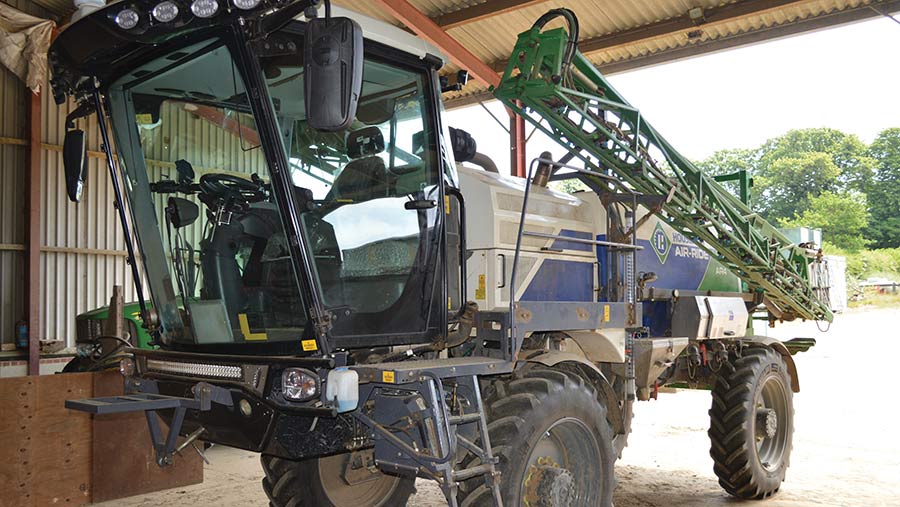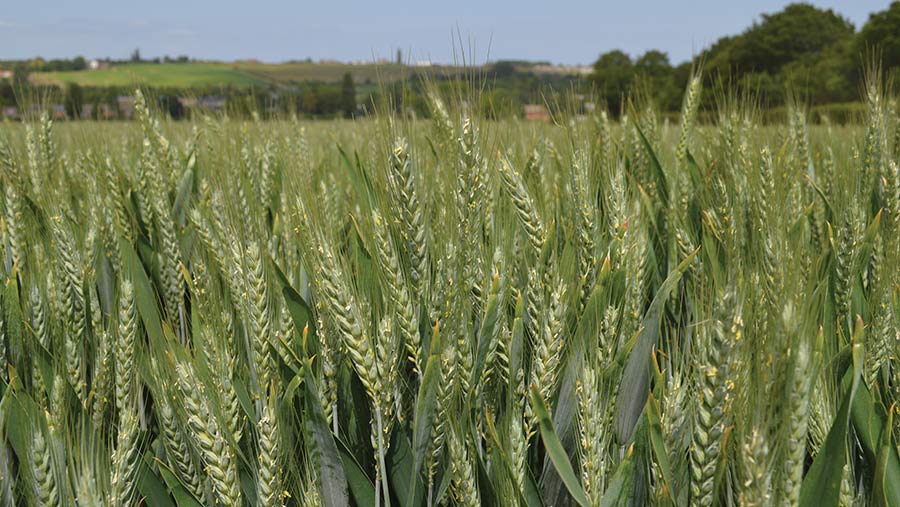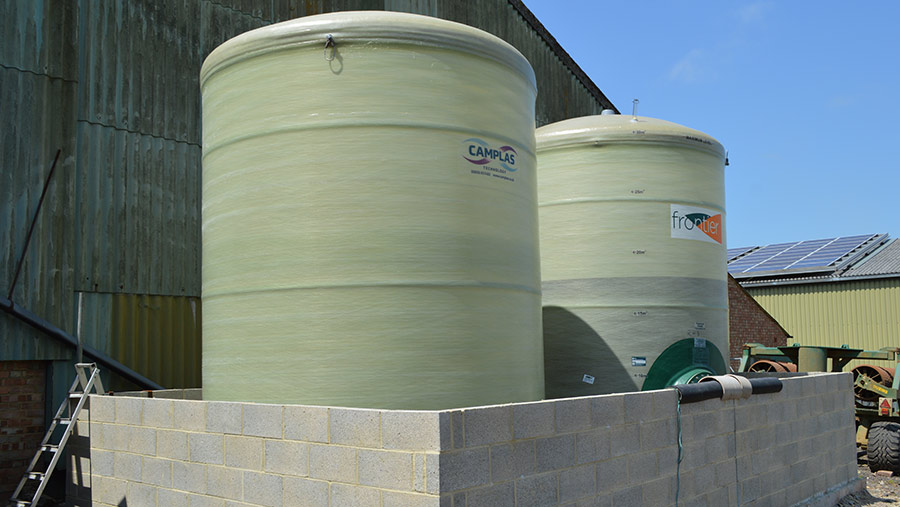What’s in Your Fertiliser Shed? Switch to liquid pays off
 Andrew Brice's self-propelled Houseman sprayer © MAG/David Jones
Andrew Brice's self-propelled Houseman sprayer © MAG/David Jones Andrew Brice has switched to using liquid nitrogen fertiliser from solid this season on his north Kent farm to improve accuracy, get his applications on earlier in the season and help the environment.
This summer he is seeing more even crops, fewer application overlaps and is looking for some good yields from his milling wheats and malting barleys to justify his investment of £5,000 in the fertiliser switchover.
He has seen little crop scorch damage in his first season with liquid nitrogen and no bottlenecks with sprayer capacity, as he is applying sprays and fertiliser with the same self-propelled Househam sprayer on his farm near the River Medway.
“I am impressed with the evenness of the crops across the whole field, especially the headlands, and hope to see less incidents of lodging if we get heavy summer rain and wind,” he tells Farmers Weekly.
See also: Grower’s soils improve and inputs reduce with regen approach
Farm facts
W St. J Brice Ltd, Church Farm, Hoo, Rochester, Kent

Andrew Brice © MAG/David Jones
- Farming 360ha of medium to light arable soils
- Growing 180ha of winter wheat varieties Skyfall and Extase, 90ha of spring barley variety Skyway, and 90ha of spring beans
Milling wheats
Andrew is growing 180ha of the milling wheat varieties Skyfall and Extase, and by reducing any possible fertiliser overlaps, he is looking for fewer patches of crops going down, which can damage grain quality, in his wheat crop that usually gives an average yield of 9.5-9.75t/ha.
The cost of the change has been to build a bund so that supplier Frontier could install two 30,000-litre liquid fertiliser tanks providing the capacity for one application to his wheat crops. The bund provides a secure walled area to contain any spillages or leaks, protecting the environment at a cost of £5,000 for the installation.
“Accuracy is an overriding theme with using liquid, and it has worked well with our sprayer and bowser system having to cover a lot of small fields,” he adds.
Andrew had used solid ammonium nitrate in the past on his 360ha of medium to light arable soils at Church Farm, Hoo, just north-east of Rochester, growing milling wheats, spring malting barleys and spring beans, and one of his key reasons for the switch was to be able to get on early in the season.
He has been trialling a nitrification inhibitor to see what benefits may come from reducing the risk of leaching early in the season when rainfall tends to be high.
A nitrification inhibitor delays the microbial conversion in the soil of ammonium nitrogen to nitrate by temporarily suppressing the action of a soil bacteria (nitrosomonas), which is responsible for the first step of the nitrification process, and so it helps retain fertiliser nitrogen in the less-mobile ammonium form.

Andrew Brice’s Skyfall wheat crop © MAG/David Jones
Drilling time
Andrew has pushed back his winter wheat drilling date to give him more time to control grassweeds, so only starts sowing on 15 October, and therefore early spring nitrogen is key for small wheat plants coming out of the winter to encourage them to grow and tiller.
“Early nitrogen is vital, particularly for second wheats, and the use of an inhibitor allows gradual release,” he says.
Solid nitrogen applied early in the season could easily be leached away in early spring rainfall, while a dry spell on the farm, with only 550mm of annual rainfall, could see solid nitrogen fertiliser sitting on the surface and not being immediately used by plants.
The original plan on the farm was to apply the first dose of liquid fertiliser in mid-to-late February when the sprayer was free, as his later-drilled winter crops this season only come to the T0 fungicide timing in the first week of April.
However, this plan was disrupted by wet weather, and his first, and main, dose of liquid fertiliser was only applied this year in mid-April, and then two other doses followed, with the last at the flag-leaf stage in mid-May.
Min-tillage
Andrew’s wheats are established using min-tillage cultivations with phosphate and potash variably applied to chopped-straw stubbles, and a pre-emergence herbicide used and then one or two insecticides for control of aphid-spread barley yellow dwarf virus.
The first nitrogen application is of NitroFol, which is a liquid urea-ammonium nitrate (UAM) product, with a nitrification inhibitor added. This is applied at an approximate rate of 300-400 litres/ha, supplying 90-120kg/ha of nitrogen and 30-40kg/ha of sulphur in a high-volume, low-pressure application.
Charlotte Tomkins, fertiliser business development manager at agronomy group Frontier, has been advising Andrew on the fertiliser switchover alongside Frontier’s local farm trader, Ollie Wilson.
Charlotte says the use of a nitrification inhibitor can be useful for early applications to reduce the risk of leaching and slow down the availability of the nitrogen in case of heavy rainfall.
She says using a nitrification inhibitor, such as Liquisafe, early in the season to reduce leaching can be a useful tool, but as the season progresses and rainfall is lower and temperatures rise, a urease inhibitor such as Limus Perform is recommended to cut ammonia nitrogen losses from volatilisation.
Urease inhibitors have been discussed at length within the industry over the past 12-24 months and will now be mandated to be included from 1 April each year as part of the new Urea Stewardship Scheme enforced from next spring.
Nitrogen and sulphur
The subsequent two applications of NitroFol at 250-300 litres/ha – during mid-stem extension and then at flag-leaf emergence – each provided 75kg/ha of nitrogen and 25kg/ha of sulphur to bring the total nitrogen to 240kg/ha, similar to what he was applying when using solid nitrogen.
No further nitrogen was applied as the Skyfall is grown on contract for breadmaker Warburtons, which stipulates that no foliar nitrogen can be applied to the ear to boost protein, and Andrew adds that the Skyfall usually makes the 12.5% protein demanded by the breadmaker.
All the liquid nitrogen-sulphur treatments are applied through the farm’s self-propelled Househam 24m 4,000-litre sprayer, with just a switch of nozzles needed to move from fertiliser applications to agrochemical spays.
Andrew emphasises that the fertiliser applications fit in well with other sprayer demands as in a “normal” year the first application would be well before T0s, which traditionally go on at the end of March, and the other two applications fit around the “normal” T1 timing of about 20 April and T2 of around 10 May.

Liquid fertiliser tanks on the farm © MAG/David Jones
Avoiding scorch
On scorch, he points out that cool and dull weather in February and early March should be ideal for applying liquid fertiliser as scorch tends to occur on bright, sunny days, and he can apply liquid when it is difficult to spread solids.
“With solid nitrogen fertiliser, dew is the enemy, as the prills can stick in the crop and cause damage, whereas damp and humid weather is ideal for liquid,” he adds.
Charlotte points out that the cost of the liquid fertiliser regime is similar to using solids on a kg for kg basis
“Sulphur is as mobile in the soil as nitrogen, so a little-and-often approach is best for those applications. This is even more apparent this year following numerous cases of sulphur deficiency; some of these cases were systems where sulphur was all applied at the very start of the season,” she says.
Andrew is also seeing some further advantages from the switch to liquid. One is the saving in the cost of recycling the plastic bags in which the solid fertiliser used to come in, and another is the extra space in his fertiliser shed, which he can put to other uses.
He also emphasises the accuracy, which was particularly relevant in his spring barley, where his Skyway malting spring barley variety could lodge in fertiliser overlaps and affect its quality for the malting trade.
In addition, there is the added advantage of accurate application around field margins and watercourses, when Andrew can be assured that no fertiliser is going into protection buffer strips near watercourses.
See the other articles in this series
What’s in Your Fertiliser Shed? Grower favours solid nitrogen for milling wheats
What’s in Your Fertiliser Shed? Approach targets river health

